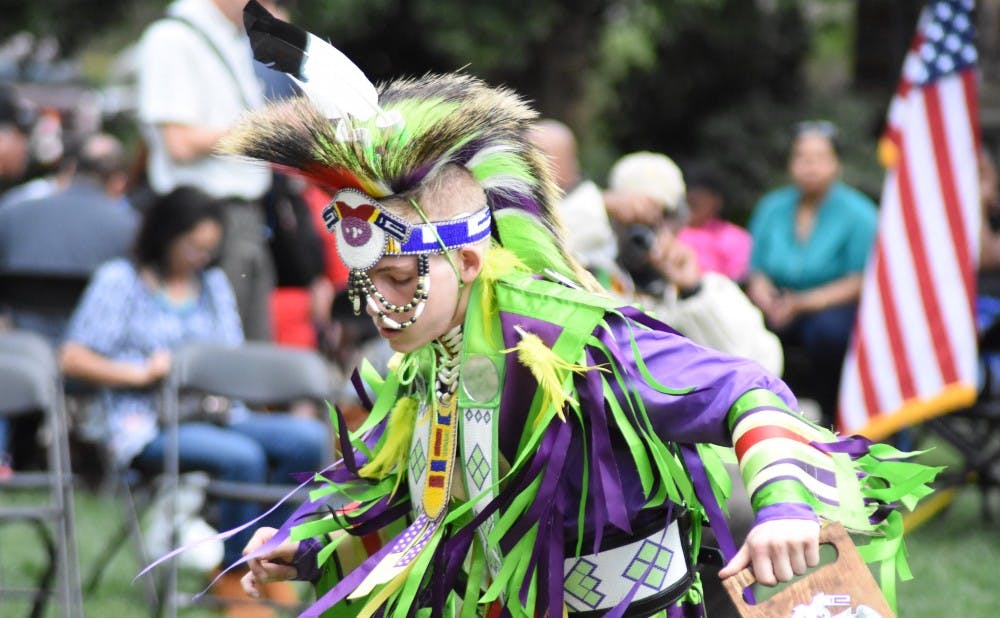On April 14, the Native American Student Alliance had its annual powwow on Abele Quad. The event drew the attention of a lot of students and alumni visitors with its tribal costumes and dances.
Generally starting in February and taking place throughout summer, powwow is a ceremony in which Native Americans come together to celebrate their cultures through praying, singing and dancing. The event has variations in different tribes — in the tribe of junior and NASA Chair Shandiin Herrera, it starts with a prayer and is mainly composed of dancing, which is a form of healing and ceremony to remember veterans.
Colleges also have their own division of powwow, but the event at Duke has mostly been involved the gathering of local North Carolinian tribes. Powwow had been held sporadically on campus until last year, especially because of the small Native American population at Duke and the scarcity of resources available to them. This year, the Center for Multicultural Affairs helped NASA organize the event.
With the help from the CMA and other members of NASA, Herrera began planning for the event in January. Having attended powwow events at other universities, including N.C. State and UNC-Chapel Hill, she was able to contact musicians and dancers from several local tribes, including Lumbee, Haliwa-Saponi and Cherokee. She also invited vendors to sell Native American crafts, ranging from jewelry to dream catchers.
“A huge part of it is having a visual event going on,” said junior Rayleigh Palmer, vice president of NASA. “Because NASA is so small, we have trouble trying to advertise who we are. So whenever we have powwow, there is dancing. There is food. It really attracts people.”
Although the event did garner attention, the Native American population at Duke remains almost unrecognizable. Despite efforts such as having a Native American student recruiter and providing opportunities for Native American high school students to visit the campus, the number of Native American students at Duke had just reached 1% of the entire student body this year. Duke also does not have any Native American faculty members.
Meanwhile, although North Carolina has one of the largest Native American populations on the east coast, there are not many students coming to Duke from North Carolinian tribes — most Native American students at Duke come from the Navajo tribe. Therefore, NASA also calls for more diversity within Native American students represented in Duke’s student body.
Because it is such small community at Duke, the powwow holds a special meaning for Native American students, despite coming from different tribes and backgrounds, as an event in which they can reconnect with their cultures.
“Especially here at Duke, it is really hard to feel connected to home,” sophomore Imani Hicks, who volunteered at the event, said. “In [my] reservation, I am constantly surrounded by Native culture. So this is the one time for me when I get to hear the drums and be around the Native American community.”
To Herrera, the event was a chance to strengthen her identity both as a scholar at Duke and a representative of her cultural traditions.
“Being at Duke and having an opportunity to bring both of my worlds together are very important to me and other Native American students,” she said. “A lot of times, we do feel left out of the conversations at Duke, because there are no Native American professors or Native American Studies program. So it is more like us having to self-advocate to see this big event happen.”
The powwow also allowed Native American students to view the event from a different perspective to explain it to non-Native American audience.
“In general, when I go back home, I just go to the powwow,” Raymond Allen, a third-year graduate school student in biology, said. “But seeing the other side of the coin, I am like, ‘This is the kind of effort that is needed to organize the event.’”
For most of the students who organized and volunteered at powwow, the event was valuable in sharing their traditions with the Duke community.
“It is not only for Native students. It is also for the general public who have never been to powwow and do not know what powwow is,” junior Amber Hall, who also took part in organizing the event, said. “It has to become this effort that not only reflects our heritage and our pride, but it also has to incorporate the element of alliance for people who want to get involved but are not necessarily Native American.”
The event was also a reminder of the presence of Native American students at Duke and the voices they deserve to have.
“Powwows are ceremonial gatherings and very cultural,” Hicks said. “It shows Duke students that we exist, [although] a lot of people do not know that there are even Native Americans on campus.”
Get The Chronicle straight to your inbox
Signup for our weekly newsletter. Cancel at any time.

